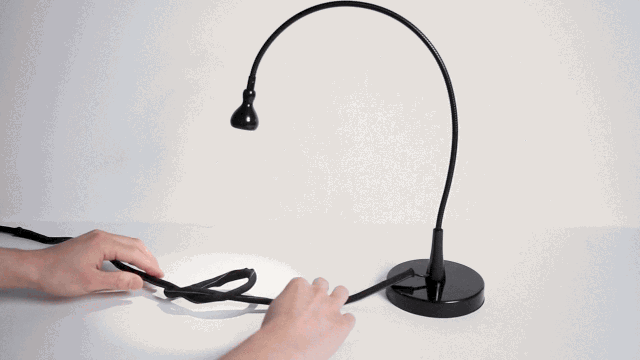Bending your lamp cord to turn off the light? Pinching your headphone cable to mute your music? A new project out of MIT is looking to change the way you look at cords by giving them superpowers.
Called Cord UIs, it's a new joint from Philipp Schoessler of MIT's Tangible Media Group, and Sang-won Leigh of the Fluid Interfaces Group, and the same team behind THAW, a magic lens that combines every screen in your life into a single user interface. This year, though, the duo wanted to revolutionize the humble cord.
"Everyone hates cables," Schoessler rightly points out. "Every device has one, and yet we see them as a nuisance. We wanted to see if we could give cords additional meaning."
For inspiration on how a cord could be used as an interface, the team looked at a water hose, which can be detached, knotted shut, or pinched to change how the water comes out of it. Why couldn't this serve as a metaphor for how the cords and cables in our lives work, too? Here are the five things Cord UIs can do.
Knotting

The most experimental of Cord UIs features is knotting: sensors that detect whether or not a knot has been tied in a cord, along with where and how tight it is to control an attached gadget. For example, by tightening a knot in a lamp's power cord, you could use it as a dimmer, or adjust three separate knots in an LED lamp corresponding to its RGB values to change the bulb's color.
Pinching

You're listening to some music on a flight. Suddenly, a stewardess leans over to try to say something to you, so you lightly pinch the cable on your headphones, instantly muting the sound. Let go, and the music plays again. Schoessler tells me that this feature would be as easy for a company to add to its headphones as building a cheap capacitive sensor into the cable and casing it in conductive thread.
Sensing Pressure

Using the same tech as the headphone cable example above, you could turn off your laptop by dropping a book on the cable, or throttle an Internet connection by putting a binder clip on an Ethernet cable.
Bending

Special cable can detect piezoelectric current, or electricity resulting from pressure. Cities often use these cables to count how many cars drive over a patch of road. Schoessler and Leigh came up with a way to use an entire cord as a simple power switch; all you have to do is bend it. For example, to turn on a lamp, just bend it like a glow stick. Want to turn it off again? Give it a quick yank.
Stretching

Leveraging existing sensors used in the robotics field to detect stretching, Cords UI can tell when you're pulling on a cable. This could be used to safely detach a USB hard drive when it senses you are about to yank it out of your laptop, or to trigger an emergency sleep mode on your computer when it detects you've just tripped over the cord.
How Practical Are Cord UIs, Really?
The guys at MIT's Tangible Media Group and Fluid Interfaces Group are known for their far-off concepts that push user interface concepts to their outer limits. So I had to ask, are Cord UIs really possible with technology that exists today, or is this another pie-in-the-sky concept that's decades away from being an everyday part of our lives, like this extraordinary shapeshifting display?
Refreshingly, the majority of the functions they're showing off with Cord UIs would be cheap and easy for companies to do today. The sensors they used for the project are cheap and plentiful, and although they used an attached Arduino (a simple, programmable circuit board) to more easily program their cables, the interactions could be achieved with simple analog electronics. There's no reason our cords can't be smarter. We just need to stop taking it for granted that cables have to be dumb.
You can read Schoessler and Leigh's full research paper on Cord UIs here.